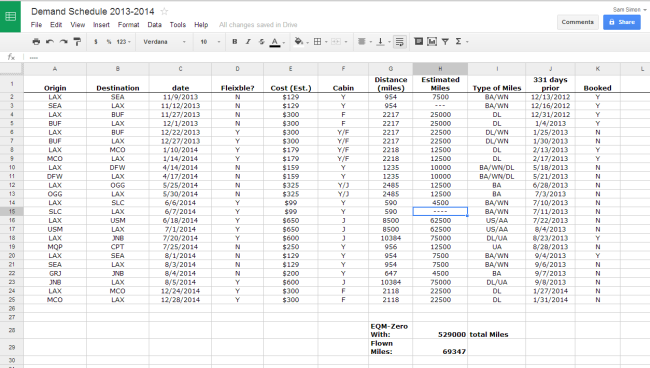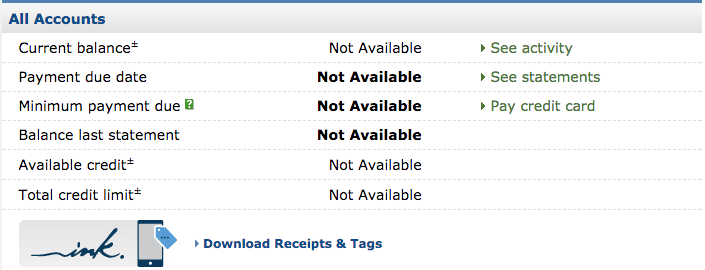We’ve been slightly sidetracked by the recent United news that came out early today. Please focus discussion on that devaluation either on FT or in the comments of the earlier post here.
I’ll do my best to get us back on track with regular Milenomics posts. I also have a special piece I’m working on regarding Milenomics Be Your Own Elite and the United Devaluation, but that will have to wait a few days.
Demand Schedules as Valuable Tools
Yesterday we went more in-depth to what a demand schedule looks like. Today we’ll talk about the benefits of using them to target your earnings. If you haven’t already, take a look at the Schedule I posted yesterday:

Having our flights laid out like this will let us know first and foremost what programs we need to focus our earnings in. I like to earn and burn, and I do that in a dual earn-dual burn form of Milenomics with my wife.
Because I earn and burn, I can book flights that I already have enough miles for, and that have firm dates right now. Then, with my demand schedule I can keep my mileage balances low–and when I earn enough miles I can book another ticket, picking my most expensive ones first–and then working my way back to the cheapest flights.
What the demand schedule lets me do is focus my earning only in the programs I will use. Miles earned in programs I don’t end up using are orphaned miles–and hoarding those miles is a good way to waste miles and money.
A Demand Schedule Limits Unnecessary Programs.
Looking at my demand schedule I’m flying into and out of a lot of Alaska Airlines serviced airports. Pretend for a moment I’m new to miles. Reading about possible credit cards out there, I see there is an Alaska Airlines card, and someone has said I should use it to earn miles and fly on Alaska.
Should I then start earning Alaska Miles? My Demand Chart helps me wade through the obvious questions:
Can I earn a 30,000-50,000 Alaska miles quickly/cheaply? Yes.
Are they the cheapest type of miles to use for my flights? No
Do I need them in the next 12 months? No
Looking at my demand schedule, the mileage balances I currently have, and the area of the country I live in (LAX) no, I don’t need AS miles. I’d be better off focusing on Avios and using those to book AS or AA flights. In addition I can use my DL Miles to fly on Alaska as well as DL. If I didn’t have my DL miles–maybe AS would work for me–but that’s something that would be flushed out by looking at my demand schedule.
Using the Demand Schedule to Determine which Miles to use
You can see my Demand Schedule is heavy with three main mileage currencies: Avios, DL miles and AA/US. Use your schedule and a route map (as I did yesterday) to determine where you have overlaps and can save miles. This might switch some of your flights to WN, or even Virgin America or Jetblue. The ultimate goal of Milenomics is not to be loyal to an airline, but to be loyal to saving miles, and getting our travel for less.
After studying my Demand schedule I might shift some flights to Southwest for the following reasons:
First, to not rely so heavily on Avios. I don’t have an unlimited number of them, so using WN I can dip into two different mileage pools.
Secondly, Some flights just won’t be possible with Avios–with their limited availability they often mean I need to be flexible in dates,Southwest has a fixed value point system which means every ticket is bookable with points. For less flexible flights WN will be my go to point.
Finally, this will also help burn up some of my UR that will have limited use as UA miles starting Feb 1, 2014. I haven’t fully formulated my UA and UR strategies, but as I do I’ll update the blog with ideas on how to best use them. More to follow, especially as new UA rules are firmed up in the coming weeks.
Demand Schedules’ Ability to Help Put Limits on our Earning
We discussed this briefly yesterday as well, a Demand schedule gives us a target to reach EQM-Zero. We can strategically focus earning in programs with miles we think we’ll need, and not just have large pools of miles sitting around, waiting for devaluation. Looking at my demand schedule you see that I use less AA, US, and UA miles.
Currently I’m pretty low on UA miles. I had been rebuilding my UR thinking I’d use them for UA in the future. My AA and US stashes are pretty stocked up– ready for another international trip whenever that might be. Because of this I’ve stopped any and all earning of AA and US miles. I’ll also stop UR earning right now, and shift to MR until I figure out my UR and UA strategise.
Any extra capacity should now go to cash back cards, avios (Via MR), and DL miles for me until my demands are met, and then new demands can be looked at and earning can be tailored around that.
Wrapping it Up
We’re looking at our travel as a complete picture when we have a demand schedule. Because we can see the picture more clearly we can craft our plan based on the flights we need to take. Remember–what works for me might not work for you, and what works for you might not work for anyone else. Milenomics is about being the best traveler you can be–not winning an imaginary contest against the world.
Together we can travel more, for less. Together we’re Milenomics.




what do you think of the samuel l jackson capital one quicksilver card?
I’m going to wait until April First to apply for that one. 😉